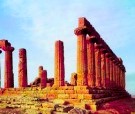|
|
 |
I PARCHI LETTERARI "IN THE DIMENSION OF THE JOURNEY" -
THE PLACES: AGRIGENTO
|
Ancient Akragas,
which Pindaro called:
"the most beautiful
city of mortal beings".
“I beg of you, merry with feasts, splendid
among the cities of men,
dwelling of Persiphone, which you are,
along the banks of the Acragas
rich with flocks of sheep, above the solid hills”
(Pindaro, Pitica 12) |
 |
|
|
| |
|
There a wind endures that I remember
kindled in the manes of horses
racing aslant across the plains, a wind
that stains and scars the sandstone
and the heart of mournful telamones toppled
on the grass. Aged soul, grey with rancor
return to that wind, breathe in
the delicate musk that clothes
the giants cast down by heaven.
How alone in the space that's left to you!
And more do you grieve if still you hear
the sound that drifts toward the sea
where Hesperus trails at early morn
the jew's harp's melanchonic twang
in the throat of the cartman
who slowly ascends the moon-cleansed hill
mid the murmur of moorish olive trees.
(Salvatore Quasimodo, The Road to
Agrigentum) |
 |
AGRIGENTO: the sea
that separates the island from Africa can be seen from
the low hills. Everything is green during the winter and
the almond flowers are a portent of spring’s
arrival, but in summer the land that is scorched by the
sun turns yellow. The light is always intense; the sky
is rarely hidden by clouds. Already perched high on a
hill, the city reigns – and now threatens with
disorderly extensions of uneven buildings – the large
field of the ruins of the Greek city of Akraga
and the Valley of the Temples with its Doric
columns made of tuff, sacred buildings that either
survived or were re-erected, along a trench that
surrounds the valley. Down below, there are the memories
and vestiges of the city, which saw someone with a
golden diadem, dressed in crimson, walking ahead,
followed by reverent students: this was Empedocles, the
philosopher, physician and investigator of nature. High
above are the homes, the streets and the atmosphere of
this city, first Arab, then Medieval and then Baroque.
“In any case, a sense of great perfection permeates
from each phase of its construction. Perhaps this is
what had already attracted hordes of travellers even in
late antiquity, and which still moves them today.” (E.
Jünger).
“Throughout the existence of Agrigento there has even
been an abundance of strange, beautiful, important and
splendid figures that are on the tongues of all. Because
this was one of the most marvellous Hellenic cities, of
course not as powerful as Siracusa, but just as rich,
abundant and no less entertaining and happily equipped.
 Even
long before the Greeks, it was the Sicanian capital.
According to the chronicles of Diodorus, the Sicanian
King Kokalos had welcomed Dedalus, who had fled from
Crete and who built him a castle on the hill of Kamikos. Even
long before the Greeks, it was the Sicanian capital.
According to the chronicles of Diodorus, the Sicanian
King Kokalos had welcomed Dedalus, who had fled from
Crete and who built him a castle on the hill of Kamikos.
... Hellenistic Agrigento was founded in the second year
of the XLI Olympics (582 B.C.) as a colonial city of
nearby Gela and soon it overtook its mother in size and
wealth, given that trade with Carthage offered rapid
growth.
... Diodorus tells us much about the life of Agrigento.
He says that there was great abundance because the
inhabitants had covered their land with grapevines and
olive trees and given that they had undertaken trade
with Libya, they became rich.
... ”The people, says Diodorus, were used to abundance
from childhood. They wore the most delicate clothing and
golden jewels. Above all they had silver and gold combs
and bottles perfume.”
("Travels to Naples and Sicily” by
Ferdinand Gregorovius)
In the following centuries, the endless battles between
the Greeks and the Carthaginians, with whom Akragas was
finally forced to align, resulted in a slow decline.
Rome conquered it with an attack in 262 and definitively
occupied the city until 210 B.C.
“From there, Agrigento on high seems far away
the imposing walls, at one time a creator of
magnanimous horses”
Virgil (Eneide, III, vv.703-4)
 During
the imperial age, the currents of traffic moved away
from Sicily and for the Roman Agrigentum it was
an irreversible decline. During the Byzantine era, the
city was abandoned and the survivors settled on the
western hill, occupied by Muslims in 828, and named it
Girgenti, which was quickly repopulated. A system
of roads that is rich in Islamic urban elements (alleys
and courtyards) characterised the new city. After the
Norman conquest in 1087, and the Swabian rule that
followed, it became the meeting point for the Muslims of
Sicily and Girgenti was able to maintain its economic
power as a result of trade with northern Africa. In the
following centuries, once these ties had been broken,
the city was again abandoned in favour of the fiefdoms,
remaining a residence for barons and religious orders
that constructed buildings and convents. With the
economic recovery that took place during the 18th
Century, the city centre moved from the area near the
Cathedral to via Atenea, and in the 19th Century the
opening of the “Promenade”, today Viale della Vittoria,
and the demolition of Porta di Ponte, which would later
become the site of Piazzale Roma (today Aldo Moro),
sanctioned the new expansion in the direction of the
southeast. During
the imperial age, the currents of traffic moved away
from Sicily and for the Roman Agrigentum it was
an irreversible decline. During the Byzantine era, the
city was abandoned and the survivors settled on the
western hill, occupied by Muslims in 828, and named it
Girgenti, which was quickly repopulated. A system
of roads that is rich in Islamic urban elements (alleys
and courtyards) characterised the new city. After the
Norman conquest in 1087, and the Swabian rule that
followed, it became the meeting point for the Muslims of
Sicily and Girgenti was able to maintain its economic
power as a result of trade with northern Africa. In the
following centuries, once these ties had been broken,
the city was again abandoned in favour of the fiefdoms,
remaining a residence for barons and religious orders
that constructed buildings and convents. With the
economic recovery that took place during the 18th
Century, the city centre moved from the area near the
Cathedral to via Atenea, and in the 19th Century the
opening of the “Promenade”, today Viale della Vittoria,
and the demolition of Porta di Ponte, which would later
become the site of Piazzale Roma (today Aldo Moro),
sanctioned the new expansion in the direction of the
southeast.
In 1927, the city abandoned the name it had known for
centuries, Grigenti, and replaced it with Agrigento, the
Italianised form of its Latin name.
Along the main road – via Atenea –
the heart of the city can be reached.
“he cathedral is large, luminous and at the same time
has an entirely modern acoustic structure and when
standing out of the church, facing the wall, it is
possible to clearly hear what is being said at the
church’s entrance.”
(F. Münter)
“The main church has an ancient sarcophagus with relief
carvings that recount the story of Hippolytus (this is
the famous Sarcophagus of Phaedra, a marble Roman
masterpiece from the 2nd Century A.D.)... The church
that houses this sarcophagus has extraordinary
acoustics... a person near the altar, right under the
dome, can hear everything that is whispered near the
church’s entrance, in other words, 116 steps away.”
(Stolberg)
“Needing to rest, that day I limited myself to seeing
what was most notable in the city: for this reason I
went to the cathedral where I had the chance to admire
the piece that is currently used as a baptismal font,
one of the most excellent and perhaps the most beautiful
of all the ancient marble bas-reliefs that have been
left to us over time.
... After having examined this urn at length and with
great care, I still remained somewhat undecided as to
whether this represented the story of Hippolytus and
Phaedra, his stepmother...”
(“The Sarcophagus of Fedra”, taken from
The Journey to Sicily by the Barone di Riedesel
– Palermo, 1821)
“All sorts of populations invaded and dominated this
land, one after another, so strong was the yearning to
possess it. It is the land of oranges, of flowering
gardens, of the perfumed air... But what makes its visit
indispensable to me is that it can be defined as a
strange and divine museum of architecture.” (Guy
de Maupassant)
From our windows, the gaze looks
over the large, wide slope of the ancient city...
In his book Journey to Sicily, Goethe
wrote:
“Since there was no hotel in this city, a kind family
welcomed us, allowing us to use a large alcove located
at the back of a large room. A green curtain separated
us and our belongings from the family members, who in
this large room manufactured their fine quality
maccheroni, and among the most expensive of these are
the ones that after being formed in perforated rollers,
are turned inside out by hand to take on a special
shape.”
The location of this home has been identified as the
current Via Atenea.
Then Goethe describes the scene observed from the
house where he was staying:
“Never before in all our lives were we given the
chance to enjoy such a splendid vision of spring like
that of this week at sunrise... From our windows our
gaze falls upon the large, wide slope of the ancient
city, all gardens and vineyards; under all of that
vegetation who could have ever suspected there was any
trace of the vast and populous neighbourhoods that have
now disappeared? Only towards the southernmost point of
this verdant and flowering elevation can the temple of
Concordia be seen rising up, while towards the east,
there are the few on high, but the eye quickly moves
down towards the plain of ruins of the temple of Juno;
the ruins of other sacred buildings, all in a straight
line with the others, the southern coastlines are not
visible, which for another half hour of road extend to
the seaside.”
And many others have looked out
on to that same panorama...
“The city is found four miles from the sea, on the
summit of a mountain where an ancient Greek acropolis
once stood. If I have ever fully felt that delicious
feeling that a beautiful view and a lovely position can
inspire, it was in the early morning, casting my gaze
across the countryside that can be seen from the
Agostinian convent where I was staying.” (Riedesel)
“I spent the evening on the terrace of the hotel
“Belvedere”, which dominates the entire plateau. I was
alone with my thoughts. I saw a fiery sunset, then the
violet dusk, and then it was night. The lights of the
city were turned on; down there the lighthouse of Porto
Em¬pedocle began to shine as did the stars above my
head. The noises died down, and slowly, all around me
everything became dark in the sleeping homes. Then the
moon rose up from the sea, red, large and quick, it
slowed its ascent and became small, white and cold. In
the half-light of the moonbeams, I caught another
glimpse of Agrigento. The black earth began to fall away,
tracing trenches and fields, from below, woods of olive
trees emerged as dark columns. That night I stayed there
for a very long time, in the ecstasy of quiet
contemplation.”
Tract of Sicily 1898 – note from a bicycle
journey by Luigi Vittorio Bertarelli
“From the window of the hotel which is high on a
hill, my gaze, like one of the many crows that at that
moment hover in the air, cawing, looks out on the vast
landscape of the Valley of the Temples. From the dark
and shredded clouds that travel quickly across the grey
background of the sky, a light rain falls, brilliant,
silent. Beyond the rows of trees and wheat fields and
vineyards and vegetable gardens and farmsteads and
gardens, the three elevations with the miniscule yet
perfect temples, are outlined like three remote crosses
set against the smoky backdrop of the sea” (Moravia)
The Valley of the Temples...
Guy de Maupassant, in
Travels in Sicily writes of the temples of
Agrigento:
“They seem to be erect in the air, in the middle
of a magnificent and desolate landscape... They, the
temples, eternal dwellings of the gods, dead like
the men who were their brothers, rest on the wild
hill, separated one from another by about a half
kilometre.”
“Seated along the road that runs along the base of
the surprising mountain rib, you remain there to
dream in front of these marvellous memories of the
greatest population of artists. You have the
impression that all of Olympus in front of you; the
Olympus of Homer, of Ovid, of Virgil, the Olympus of
those gracious, carnal, impassioned souls like
ourselves, who poetically personified all of the
tenderness of our souls, all of the dreams of our
minds, all of the instincts of our senses.”
...
“Girgenti, ancient Agrigento, offers a combination
of the most surprising temples that has been offered
for contemplation. On the long tract of rocky coast,
nude, a fiery red colour and without a blade of
grass nor a shrub, looking over the sea, the beach
and the port, the great stone profile of the three
superb temples is cut out against the blue sky of
the hot towns. They seem to be suspended in the air,
in the middle of a magnificent and desolate
landscape. Around, in front of and behind them,
everything is dead, arid and turned to yellow. The
sun has burned, consumed the earth. But was it the
sun that made it this way, or rather the deep fire
that burns in the veins of this island of volcanoes?
Everywhere, all around Grigenti, the singular
district of the sulphur mines stretches out. Here,
everything is sulphur: the earth, the stones, the
sand, everything. They, the temples, the eternal
dwellings of the gods, dead like the men who were
their brothers, rest on the wild hill, separated
from one another by half a kilometre.” (Guy
de Maupassant)
“To the left, there was the African Sea, calm,
blue and immense; behind us the temples of Juno
Lucina and of Concordia; finally at our feet, still
displaying the traces of the carts, the ancient
road, the same that was used two thousand years
before, by that population whose tombs we walked
alongside.” (A. Dumas)
The Temple
of Zeus at Agrigento
|
|
Sitting on the
grass, the girl lifts
the rough hair from the nape of her neck
and laughs at the race and the lost comb.
She does not tell of the colour or whether
it was ripped from the burning hand that
from
waves from behind an almond tree in the
distance or if it was on the Greek
deer mosaic at the bank of the river
or in a ditch of violet thorns.
And the folly of the senses laughs, it
laughs
continuing on skin of the island’s
afternoon heat
and the bright, buzzing, quick bee
poisons and mistletoes of infantile embraces.
We watch this symbol of ironic falsity
in silence: and the daytime moon burns
inside out for us and falls into the
vertical
fire. What future can the Doric well
read for us, what memory?
|
The pail comes
up slowly
from the bottom and brings
plants, and faces just encountered.
You turn, you ancient wheel of tremors
your heavy heart, preparing the day,
careful at all times, what ruin you make of
the angelic images and miracles
that the sea offers in the narrow light
of an eye! The telamon is here, two steps
from Ade (sultry, immobile murmur)
distended in the garden of Zeus and crumbles
its rock with the patience of airborne
maggots:
it is here, stage by stage
among eternal trees from a single seed.
|
|
Salvatore Quasimodo,
“The False and the True Green” (1954) |
Leaving Agrigento, before continuing eastward along the
coast, the Storyteller of I Parchi Letterari®® “In the
Dimension of the Journey” accompanies us again for a
brief inland stopover where a poem as a model reminds us
of the many Arab travellers and the long period of time
that the people of that culture dominated Sicily...
Go to Favara
>>
|






 Regione Calabria
Regione Calabria



